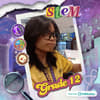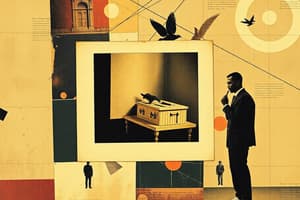Podcast
Questions and Answers
Which of the following best describes 'information' in the context of organizational operations?
Which of the following best describes 'information' in the context of organizational operations?
- A set of interconnected components working towards a specific purpose.
- Processed data that is meaningful and useful for decision-making. (correct)
- Raw, unprocessed facts collected from various sources.
- The hardware components of a computer system.
Which characteristic distinguishes Web 3.0 from Web 1.0 and Web 2.0?
Which characteristic distinguishes Web 3.0 from Web 1.0 and Web 2.0?
- Its reliance on artificial intelligence. (correct)
- Its independence from AI.
- Its interactive capabilities.
- Its static nature.
Which of the following is the main goal of Management Information Systems (MIS)?
Which of the following is the main goal of Management Information Systems (MIS)?
- Developing new technologies for entertainment purposes.
- Collecting, processing, and disseminating information to support organizational decision-making. (correct)
- Simulating human intelligence through machines.
- Managing a company's financial resources.
Which statement accurately describes the relationship between hardware and software in an information system?
Which statement accurately describes the relationship between hardware and software in an information system?
Which of the following is NOT typically considered a component of an information system?
Which of the following is NOT typically considered a component of an information system?
Which action exemplifies 'managing' within the context of the management process?
Which action exemplifies 'managing' within the context of the management process?
Which of the following statements about RAM (Random-Access Memory) is correct?
Which of the following statements about RAM (Random-Access Memory) is correct?
What primarily differentiates application software from operating system software?
What primarily differentiates application software from operating system software?
Why is investing in the appropriate hardware critical for an MIS?
Why is investing in the appropriate hardware critical for an MIS?
In the context of Management Information Systems (MIS), what does 'process' refer to?
In the context of Management Information Systems (MIS), what does 'process' refer to?
How might modern information systems improve organizational processes?
How might modern information systems improve organizational processes?
A company is deciding between HDD and SSD for their new office computers. Which consideration is MOST accurate when making this decision?
A company is deciding between HDD and SSD for their new office computers. Which consideration is MOST accurate when making this decision?
What role do communication networks play in modern computing environments?
What role do communication networks play in modern computing environments?
How would you best describe a 'system'?
How would you best describe a 'system'?
Why are organizational, management, and cultural changes often required for firms to derive full business value from IT investments?
Why are organizational, management, and cultural changes often required for firms to derive full business value from IT investments?
Which of the following is NOT an example of hardware?
Which of the following is NOT an example of hardware?
Which of the following statements is true regarding digital devices and signals?
Which of the following statements is true regarding digital devices and signals?
How many bytes are in a kilobyte?
How many bytes are in a kilobyte?
In the context of computer technology, what does the term 'bus' refer to?
In the context of computer technology, what does the term 'bus' refer to?
Which component is considered to be the 'core' of a computer?
Which component is considered to be the 'core' of a computer?
Flashcards
Information
Information
Processed data that is meaningful and useful for decision-making. It provides insights and supports strategic decisions.
Data
Data
Raw, unprocessed facts and figures collected from various sources, serving as the foundation for creating meaningful information through processing and analysis.
System
System
A set of interconnected components that work together to achieve a specific purpose.
Management
Management
Signup and view all the flashcards
Web 1.0
Web 1.0
Signup and view all the flashcards
Web 2.0
Web 2.0
Signup and view all the flashcards
Web 3.0
Web 3.0
Signup and view all the flashcards
Information Systems
Information Systems
Signup and view all the flashcards
Artificial Intelligence (AI)
Artificial Intelligence (AI)
Signup and view all the flashcards
Management Information Systems (MIS)
Management Information Systems (MIS)
Signup and view all the flashcards
Hardware
Hardware
Signup and view all the flashcards
Software
Software
Signup and view all the flashcards
Data
Data
Signup and view all the flashcards
Process
Process
Signup and view all the flashcards
Mainframe Computers
Mainframe Computers
Signup and view all the flashcards
Client-Server
Client-Server
Signup and view all the flashcards
Operating System
Operating System
Signup and view all the flashcards
Application Software
Application Software
Signup and view all the flashcards
Data Capacity
Data Capacity
Signup and view all the flashcards
Bus
Bus
Signup and view all the flashcards
Study Notes
- In 1989, Tim Berners-Lee developed the World Wide Web to simplify information sharing for researchers on the Internet.
Information and Data
- Information is processed data that is meaningful and useful for decision-making, providing insights and supporting strategic, tactical, and operational decisions.
- Data refers to raw and unprocessed facts and figures from various sources.
- Data is typically devoid of meaning on their own but can be analyzed and processed to create information.
Systems and Management
- A system is a set of interconnected components working together to achieve a specific purpose.
- Management is the process of planning, organizing, leading, and controlling resources to achieve organizational goals efficiently and effectively.
Web Technologies
- Web 1.0 is a static Web built with HTML.
- Web 2.0 is an interactive Web.
- Web 3.0 is an interactive Web powered by AI.
Systems and Technology Defined
- A system is a method or process of grouping things together.
- Information systems combine hardware, software, and telecommunications networks for collecting, creating, and distributing useful data.
- Technology originally referred to the systematic treatment of arts or crafts.
Historical and Modern Technologies
- Historical technologies include fundamental inventions for transportation, machinery and revolutionized knowledge distribution.
- Modern technologies enable communication, productivity, and entertainment through devices and inventions.
Emerging Tech
- Artificial Intelligence (AI) involves machines that simulate human intelligence, such as chatbots and recommendation systems.
- Management Information Systems (MIS) is a structured approach to gather, process, store, and disseminate information for decision-making, coordination, control, analysis, and visualization within an organization.
MIS True/False Review
- False: Microphones are input devices, not output devices.
- False: Touch screen monitors are input and output devices
- True: Linux is a version of the Unix operating system.
- False: Unix is an operating system not application software.
- True: Printers, monitors, speakers, and portable media players are examples of output devices.
- False: IBM, not Microsoft, introduced the Macintosh computer in 1984 with the first commercially successful GUI.
- True: In MIS, management uses information to support decision-making at various levels.
- False: An information system integrates hardware, software, data, people, and processes to collect, process, and deliver information.
- True: Wi-fi networks, search services, and printers in computer labs are examples of IT infrastructure.
- True: Organizational, management, and cultural changes are required for firms to derive full business value from IT investments.
- False: It's essential, not optional, for organizations to take advantage of opportunities provided by new technology to win the competition.
- False: A reliable MIS can function with either hardware or software
- True: Investing in the right hardware ensures better system performance, security, and scalability, which improves business operations and decision-making.
- False: The USB flash drive is a storage device
- True: Most modern motherboards have integrated components, such as network interface card, video, and sound processing.
- False: Applications running on the computer are loaded into RAM for processing.
- True: RAM is volatile, meaning data is lost when the computer is turned off.
- False: Choose SSD for faster performance and HDD for more affordable storage. Data is written faster to SSD drive
MIS Components
- Hardware is the tangible, physical part of an information system.
- Examples include computers, keyboards, disk drives, and flash drives.
- Software comprises the instructions that tell the hardware what to do and is not tangible.
- Data is a collection of facts, like addresses, phone numbers, and social networking accounts.
- People, from front-line user support to the chief information officer (CIO), are a focus in information systems.
- A process is a series of steps undertaken to achieve a desired outcome or goal.
- Information systems improve productivity and control by integrating more with organizational processes.
Standalone System and Planning
- Standalone information systems lack communication capabilities.
- MRP stands for Manufacturing Resources Planning.
Mainframe and Client-Server Computing
- Mainframe computers were intended for centralized processing, allowing multiple users to connect to a single mainframe for processing power and data storage.
- Client-server architecture allows users to log in to the Local Area Network (LAN) from their PC (the "client") by connecting to a central "server."
IT Innovations
- IT Innovations include: Artificial Intelligence (AI) & Machine Learning, Cloud Computing, Blockchain Technology, 5G Networks, Internet of Things (IoT), Virtual Reality (VR) and Augmented Reality (AR), Quantum Computing, Robotic Process Automation (RPA), Edge Computing, Biometric Authentication, Voice Assistants, Big Data and Data Analytics, 3D Printing, Autonomous Systems and Cybersecurity Innovations
Management Changes and Hardware
- These are the Management Changes, adapt to a rapidly changing environment
- Hardware refers to the physical parts of computing devices.
Hardware in MIS
- The importance of hardware to MIS
- Data Processing & Computation
- Data Storage & Management
- Networking & Communication
- Security & Reliability
- User Interaction & Accessibility
- Scalability & Performance
- Automation & Integration
Digital Devices
- A digital device processes electronic signals into discrete values (binary).
- Analog signals are continuous and represented by a smooth wave pattern.
- Binary is typically represented as "0" meaning "OFF" and "1" meaning "ON".
- Data Capacity - The maximum amount of data a storage device or system can hold
Bits and Bytes
- Prefixes were applied to the word byte to represent different orders of magnitude.
- There are 8 bits in 1 byte.
- 1024 Bytes = 1 KB
Computer Components
- The System Unit is the main part of a microcomputer, sometimes called the chassis.
- The Motherboard is the main circuit board on the computer.
Operating System (OS)
- Loaded first by the boot program, the OS manages all programs, including file, memory, and application software.
- When a computer boots, it loads information from storage into Random-Access Memory (RAM).
- A Bus refers to the electrical connections between different computer components.
- The Central Processing Unit is the core of a computer
OS and Networking
- The Operating System manages hardware and the interface between the hardware and the user.
- Network Connections provide connections between the computer and communications networks, enabling data exchange.
Software Types
- Application Software performs specific tasks like word processing, accounting, database management, video games, or browsing the web.
- GUI stands for Graphical User Interface.
- The best example of a Wide Area Network is the INTERNET.
- IoT stands for Internet of Things
Types of Software
- Operating System
- Application Software
PC/Laptop Factors
- Factors to consider when buying a PC or Laptop:
- Processor
- RAM
- VRAM (Graphics)
- SSD (Storage Capacity)
- Operating System (Windows 11 or up)
- Upgradeability
- Brand and warranty
Studying That Suits You
Use AI to generate personalized quizzes and flashcards to suit your learning preferences.





